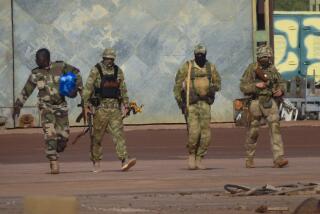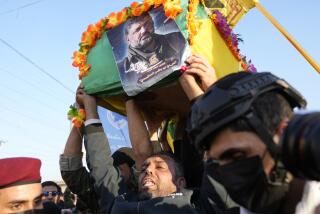Shabab’s brutal warlord sent a message with Kenya mall attack
JOHANNESBURG, South Africa — The Somali warlord who claims responsibility for last month’s shopping mall attack in Kenya is a man so ruthless and ambitious that even hardened militants fear him.
According to some Islamist fighters in Somalia, Ahmed Abdi Godane is a tyrant who runs secret jails, kills too many civilians and hunts down anyone who dares speak against him. Many prominent dissenters in the Shabab, the Somali militant group, are dead or in hiding.
Godane’s brutality has cost the Shabab support in Somalia. But though diminished, the group is more dangerous than ever, analysts say.
“What has emerged is a smaller but more nimble and capable and most likely more dangerous terrorist organization,” said J. Peter Pham, director of the Africa Center at the Washington-based Atlantic Council.
The Shabab is certainly seen by the United States as dangerous enough to warrant the Oct. 5 predawn raid by Navy SEALs on the house of one of its leaders, Abdulkadir Mohamed Abdulkadir, also known as Ikrima, in Baraawe south of Mogadishu. The raid apparently wasn’t successful, but it underscores American willingness to send troops into a hostile environment to go after the Shabab’s top leadership.
Godane, who has a $7-million U.S. bounty on his head, remains a premium target, with his recent moves to seize power in the Shabab only increasing the attention on him.
The charismatic American militant Omar Hammami, known as Abu Mansour al-Amriki, who joined the Shabab in Somalia, tweeted about Godane in the weeks before the warlord’s men reportedly hunted him down and killed him last month. He said Godane had “gone mad” and was a “control freak.”
Godane, who after the mall assault in Nairobi, Kenya, vowed in an Internet audio post to carry out more attacks, has emerged as the unquestioned boss of the Shabab after killing off his rivals, some of whom had openly appealed to Al Qaeda’s leadership to stop him.
Under Godane’s leadership, the group has been through a very rough patch, with embarrassing squabbles spilling out on Twitter, large-scale defections to government forces and open mutiny by prominent leaders. As a result, many senior figures in the Somali government and the African Union force in Somalia, known as AMISOM, prematurely declared the Shabab finished.
More important for Godane was the Shabab’s image problem in the world of global militancy: The group resembled a contentious rabble, squabbling and on the run. But the attack on the Westgate shopping mall, which killed 67 civilians and soldiers, could change all that.
“It’s aimed at sending a signal within Somalia that Godane is leading Al Shabab. It’s pretty clear that at least some of the attackers were foreigners, and the target certainly included many foreigners, so it was also intended to send a signal to the international community,” Pham said.
“A high-profile attack like this is very useful for a terrorist group like Al Shabab. It has certainly now raised its profile, and that will help with both recruiting and finances.”
The attack, in which some Muslims were spared, was also designed to send a powerful message to Al Qaeda’s leadership and the shadowy funders of global terrorism that Godane and the Shabab are disciplined, effective fighters who can be relied on as the vanguard of militancy in East Africa, analysts said.
Cedric Barnes, Horn of Africa analyst at the Brussels-based International Crisis Group, said Godane and the Shabab had long threatened a major attack in Nairobi. “He’s trying to say, ‘This is Shabab and we are the No. 1 presence in East Africa.’”
Godane, 36, highly ambitious but remote from his followers, is a veteran of militant training in Afghanistan who reputedly enjoys penning poetry. He’s rarely photographed, but he releases occasional audio statements laying down the law in a droning, pious tone.
He took over the Shabab leadership in 2009 and pledged allegiance to Al Qaeda the following year. The Shabab was initially snubbed by Osama bin Laden, but after the Al Qaeda leader’s death in May 2011, the two terrorist groups affiliated early last year. After that, the internal struggles over the Shabab’s direction intensified.
Under Godane’s guidance, the group carried out brutal stonings, beheadings, amputations and killings, alienating Somalis. When famine struck the country in 2011, the Shabab blocked humanitarian aid, feeding doubt within the group about his leadership style.
In 2011, the Shabab was driven out of Mogadishu, the Somali capital, by African Union forces. Kenyan troops invaded the same year and forced the Shabab out of its southern seaports, an important source of revenue from tax and trade.
An anti-Godane faction emerged, insisting that the Shabab concentrate on Somalia, not wage global militancy. Godane’s ally, Shabab co-founder Ibrahim Haji Jama Mead, better known as Afghani, initially supported Godane’s agenda but grew concerned about his tyrannical approach, as well as his habit of jailing and harassing foreign fighters.
On April 6 of this year, Afghani posted an open letter on the Internet to Al Qaeda leader Ayman Zawahiri on behalf of the “silent majority” of Shabab fighters, appealing to him to do something about Godane, saying the Shabab had lost territory and support because of an “internal deviation.” He accused Godane of oppressing Muslims, crushing talented recruits, locking up militants in secret jails and undermining the militancy spirit.
Weeks later, Afghani and another top Shabab leader who defied Godane were killed by Godane’s men.
Two other Shabab leaders fled: Sheik Hassan Dahir Aweys defected to the Somali government, and Muktar Robow went into hiding.
Barnes said that despite losing Mogadishu and the southern port of Kismayo, the Shabab still extorts taxes and protection money from businessmen. “There’s no doubt the big towns like Mogadishu and Kismayo are still heavily infiltrated by Al Shabab,” he said.
The Shabab’s previous attacks — often suicide bombings in Mogadishu with heavy civilian casualties — required less planning and finesse than the mall operation. Before they carried out last month’s assault, terrorists rented a shop at the mall and concealed heavy weapons; they had intimate knowledge of the center’s layout and hiding places.
“It’s clear that there’s something new going on. The attack in Nairobi required weeks if not months of planning and reconnaissance and demonstrated a tactical and strategic capacity that Shabab to date has not demonstrated,” Pham said.
Analysts say the only way to defeat the Shabab is to transform Somalia into a prosperous, stable nation with jobs for the kind of young men who join its ranks.
But it’s easy for a terrorist group to wreck a fragile facade. The Shabab has shown it can undermine Somali peace, and Godane’s message to Kenyans is that he is likewise able to create chaos and destroy their country’s stability and economy.
Godane’s global ambition makes the group not only more dangerous to regional countries that have soldiers in Somalia, such as Kenya, Uganda and Burundi, but also pose a serious risk to Western countries such as the U.S. that have backed AMISOM and the Somali government, Pham said.
“I am of the belief that the appeal of Al Shabab is to a very small minority of the [Somali] diaspora [in the U.S.], but it does have a reach,” he said. “It clearly has a reach into the American homeland that no other group has.”
More to Read
Start your day right
Sign up for Essential California for news, features and recommendations from the L.A. Times and beyond in your inbox six days a week.
You may occasionally receive promotional content from the Los Angeles Times.






